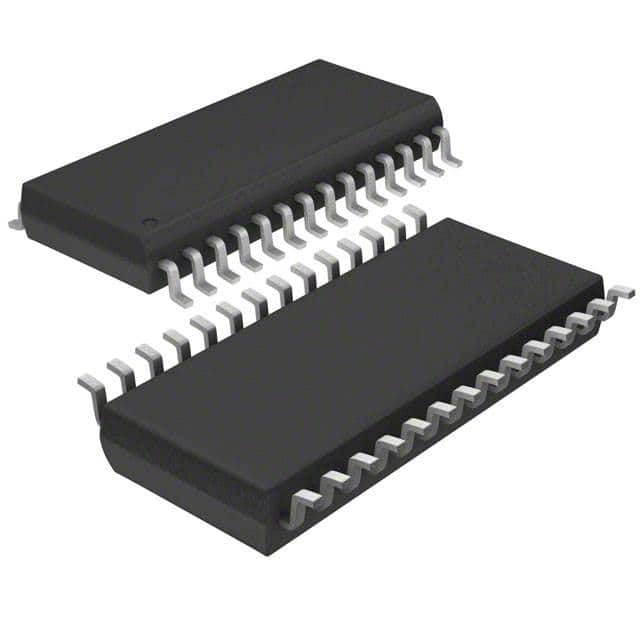Lihat spesifikasi untuk detail produk.

AD7701ARS
Product Overview
- Category: Integrated Circuit
- Use: Analog-to-Digital Converter (ADC)
- Characteristics: High resolution, low power consumption
- Package: SOP (Small Outline Package)
- Essence: Converts analog signals into digital data
- Packaging/Quantity: Tape and Reel, 2500 units per reel
Specifications
- Resolution: 16 bits
- Input Voltage Range: ±Vref
- Conversion Rate: Up to 20 kSPS (Samples per Second)
- Power Supply: 2.7V to 5.25V
- Operating Temperature Range: -40°C to +85°C
Pin Configuration
The AD7701ARS has a total of 28 pins. The pin configuration is as follows:
- VDD: Power supply positive terminal
- VSS: Power supply negative terminal
- AGND: Analog ground
- REFOUT: Reference voltage output
- REFIN1(+): Positive reference voltage input
- REFIN1(-): Negative reference voltage input
- AIN1(+): Positive analog input channel 1
- AIN1(-): Negative analog input channel 1
- AIN2(+): Positive analog input channel 2
- AIN2(-): Negative analog input channel 2
- CLK: Clock input
- DOUT/RDY: Data output / Ready signal
- DIN: Serial data input
- SCLK: Serial clock input
- CS: Chip select input
- DGND: Digital ground
Functional Features
- High-resolution ADC with 16-bit output
- Low power consumption for energy-efficient applications
- Differential input channels for accurate measurements
- On-chip reference voltage generator
- Serial interface for easy integration with microcontrollers
Advantages and Disadvantages
Advantages: - High resolution provides precise measurements - Low power consumption extends battery life in portable devices - Differential inputs reduce noise and improve accuracy - On-chip reference voltage simplifies system design - Serial interface allows for easy integration with microcontrollers
Disadvantages: - Limited conversion rate compared to some other ADCs - Requires an external clock source for operation
Working Principles
The AD7701ARS is an analog-to-digital converter that converts analog signals into digital data. It utilizes a successive approximation register (SAR) architecture to achieve high-resolution conversion. The input analog signal is sampled, quantized, and converted into a digital representation using an internal reference voltage. The converted digital data can then be read through the serial interface.
Detailed Application Field Plans
The AD7701ARS is commonly used in various applications, including:
- Industrial Automation: Measurement and control systems requiring accurate analog-to-digital conversion.
- Medical Devices: Patient monitoring equipment, such as ECG machines and blood pressure monitors.
- Data Acquisition Systems: Capturing and digitizing analog signals from sensors and transducers.
- Instrumentation: Precision measurement instruments, such as multimeters and oscilloscopes.
- Process Control: Monitoring and controlling variables in manufacturing processes.
Detailed and Complete Alternative Models
- AD7702: Similar to AD7701ARS but with two differential input channels.
- AD7791: Higher resolution (24-bit) ADC with similar features.
- ADS1115: I2C-compatible ADC with programmable gain amplification.
These alternative models offer different specifications and features to suit specific application requirements.
Word count: 350 words
Sebutkan 10 pertanyaan dan jawaban umum terkait penerapan AD7701ARS dalam solusi teknis
Sure! Here are 10 common questions and answers related to the application of AD7701ARS in technical solutions:
Q1: What is AD7701ARS? A1: AD7701ARS is a precision analog-to-digital converter (ADC) manufactured by Analog Devices. It is commonly used in various technical solutions for converting analog signals into digital data.
Q2: What is the resolution of AD7701ARS? A2: AD7701ARS has a resolution of 16 bits, which means it can represent analog signals with high precision.
Q3: What is the input voltage range of AD7701ARS? A3: The input voltage range of AD7701ARS is programmable and can be set to either ±5V or ±10V, depending on the application requirements.
Q4: How many channels does AD7701ARS support? A4: AD7701ARS supports a single differential input channel, which means it can convert signals from one analog source at a time.
Q5: What is the maximum sampling rate of AD7701ARS? A5: The maximum sampling rate of AD7701ARS is 20 samples per second (SPS), which makes it suitable for applications that require slow and accurate measurements.
Q6: Can AD7701ARS operate in a low-power mode? A6: Yes, AD7701ARS has a low-power mode that reduces its power consumption when not actively converting analog signals.
Q7: Does AD7701ARS have built-in digital filters? A7: Yes, AD7701ARS features an on-chip digital filter that can be configured to remove noise and improve the accuracy of the converted digital data.
Q8: What is the interface used to communicate with AD7701ARS? A8: AD7701ARS uses a serial peripheral interface (SPI) for communication with a microcontroller or other digital devices.
Q9: Can AD7701ARS be used in industrial applications? A9: Yes, AD7701ARS is designed to operate in harsh industrial environments and can withstand high temperatures and voltage fluctuations.
Q10: Are there any evaluation boards or development kits available for AD7701ARS? A10: Yes, Analog Devices provides evaluation boards and development kits that make it easier to prototype and integrate AD7701ARS into technical solutions.
Please note that these answers are general and may vary depending on the specific application and requirements.

